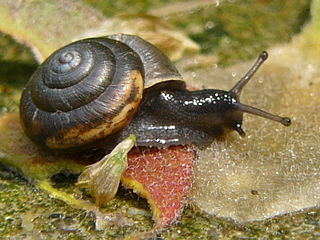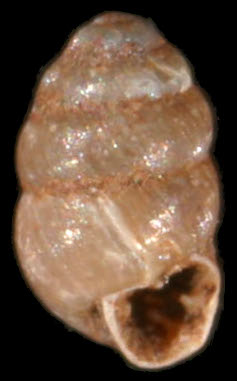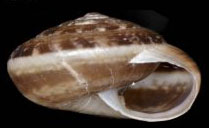
Hygromia is a genus of air-breathing land snails, terrestrial pulmonate gastropod mollusks in the family Hygromiidae, the hairy snails and their allies.

Trochulus is a genus of small air-breathing land snails, terrestrial pulmonate gastropod mollusks in the subfamily subfamily Trochulininae of the family Hygromiidae, the hairy snails and their allies.

Trochulus hispidus, previously known as Trichia hispida, common name, the "hairy snail", is a species of air-breathing land snail, a terrestrial pulmonate gastropod mollusk in the family Hygromiidae, the hairy snails and their allies.

Vertigo pygmaea, common name the "crested vertigo", is a species of minute air-breathing land snail, a terrestrial pulmonate gastropod mollusk in the family Vertiginidae, the whorl snails.

Vertigo antivertigo is a species of minute air-breathing land snail, a terrestrial pulmonate gastropod mollusc or micromollusc in the family Vertiginidae, the whorl snails.
Xerotricha conspurcata is a species of small air-breathing land snail, a terrestrial pulmonate gastropod mollusk in the family Geomitridae.

Succinella oblonga is a species of air-breathing land snail, a terrestrial pulmonate gastropod mollusc in the family Succineidae.

Hygromia limbata is a species of small air-breathing land snail, a terrestrial pulmonate gastropod mollusc in the family Hygromiidae.

Sphincterochila candidissima is a species of air-breathing land snail, a terrestrial pulmonate gastropod mollusk in the family Sphincterochilidae.
Lozekia transsilvanica is a species of small air-breathing land snail, a terrestrial pulmonate gastropod mollusk in the family Hygromiidae, the hairy snails and their allies. This species is also known as Hygromia transsylvanica.

Aforia staminea is a species of sea snail, a marine gastropod mollusk in the family Cochlespiridae.

Clionella confusa is a species of sea snail, a marine gastropod mollusk in the family Clavatulidae.

Eucyclotoma tricarinata is a species of sea snail, a marine gastropod mollusk in the family Raphitomidae.

Helix melanostoma is a species of air-breathing land snail, a terrestrial pulmonate gastropod mollusk in the subfamily Helicinae of the family Helicidae, the typical snails.

Xeroplexa arrabidensis is a species of air-breathing land snail, a terrestrial pulmonate gastropod mollusk in the family Geomitridae.

Xeroplexa ponsulensis is a species of air-breathing land snail, a terrestrial pulmonate gastropod mollusk in the family Geomitridae.



















